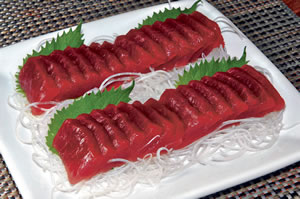A Potential Holiday Ahi Price Break

Holiday sashimi may be more affordable this year. Nathalie Walker photo nwalker@midweek.com
It happens right about now each year. Island families start scanning prices at their favorite stores, wondering how much they’ll be spending for that slab of ahi for their holiday gatherings. Many people are willing to pay top dollar to ring in the new year: anywhere from $13 to $35 per pound for ahi during the week leading up to New Year’s Eve.
“It’s tradition for everybody to have sashimi or, for some people, it’s onaga or ehu,” says Guy Tamashiro of Tamashiro Market. “It’s all about supply and demand.”
“We always get highgrade ahi no matter what the price,” chuckles Ramon Gonsalves. “Every year I say I’m not going to spend that kind of money for ahi, but I do and I’ll probably do it again.”
But he and other sashimi lovers may see a break in some of those high prices this year for the fresh, ruby red fish. The National Oceanic and Atmospheric Administration’s National Marine Fisheries Service announced it will not impose a ban on bigeye tuna fishing for Hawaii’s longline fishermen this year. This marks the first time since the inception of a big eye tuna ban in 2009 that Hawaii longliners will be allowed to fish for bigeye tuna the entire year.
“I’m hoping the boats come back loaded with fish!” says Gonsalves.
Last year, fishermen hit their limit of just over 3,700 metric tons or about 8 million pounds of ahi by Nov. 21, and NOAA officials closed western and central Pacific fisheries, sending fishermen to other areas. As a result, we saw different type fish on the line such as opah.
But after recently reassessing the catch amounts, National Marine Fisheries projected Hawaii’s longliners will not reach the limit of 3,753 metric tons for bigeye tuna in 2011, so the ban was lifted. The news was welcomed by fishermen and store owners, who believe consumers should expect more fresh fish for their New Year’s Eve sashimi and poke. And more fish should result in lower prices.
“This is a great example of the working partnership between the National Marine Fisheries Service and our longline fishermen,” says U.S. Rep. Colleen Hanabusa, a member of the House Subcommittee on Fisheries, Wildlife, Oceans and Insular Affairs. “I am pleased that both groups have demonstrated a commitment to balancing our need for sustainable fishing stocks with protecting fishing jobs, and ensuring Hawaii’s families have fresh and affordable sashimi and ahi poke on their tables this holiday season.”
“I hope we see lower prices this year, but they still have to catch the ahi,” laughs Gonsalves. “If not, we still going pay high prices, especially for the high-grade stuff.”
This year’s closing was scheduled to begin Nov. 27 and continue for the rest of the year. As a result, buyers who gather every morning at the United Fishing Agency fish auction at Pier 38 believe the action will be fast-paced into the holidays. And they say all eyes will be on supply and quality during the peak time period, when as much as a 100,000 pounds of fresh fish are sold daily and about half of that is the highly sought after ahi.
The ban was initially put into place to help reduce overfishing by 30 percent. And while industry insiders say most Hawaii’s longliners obey limits set by the agency, there are some renegades who ruin it for everyone by breaking the rules.
It’s too early to say if those rule-breakers are changing their ways or if the population of bigeye tuna is increasing. But what we do know is this is the first year longliners are being allowed to fish the entire year since the limits were set in 2009, and we may all benefit when we purchase that premium cut of fatty, firm, red ahi.



